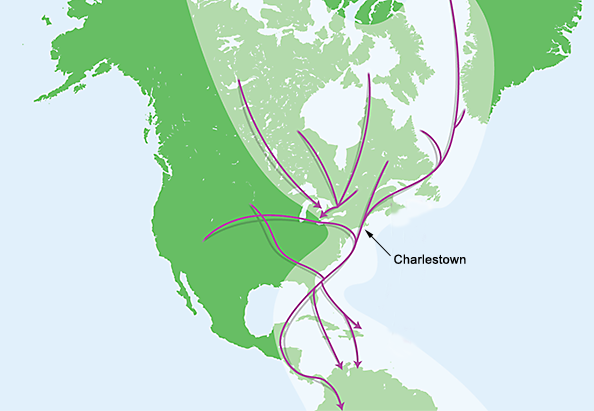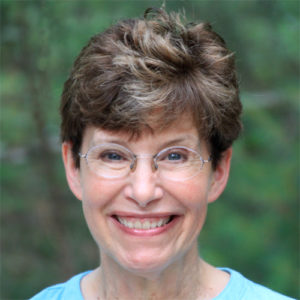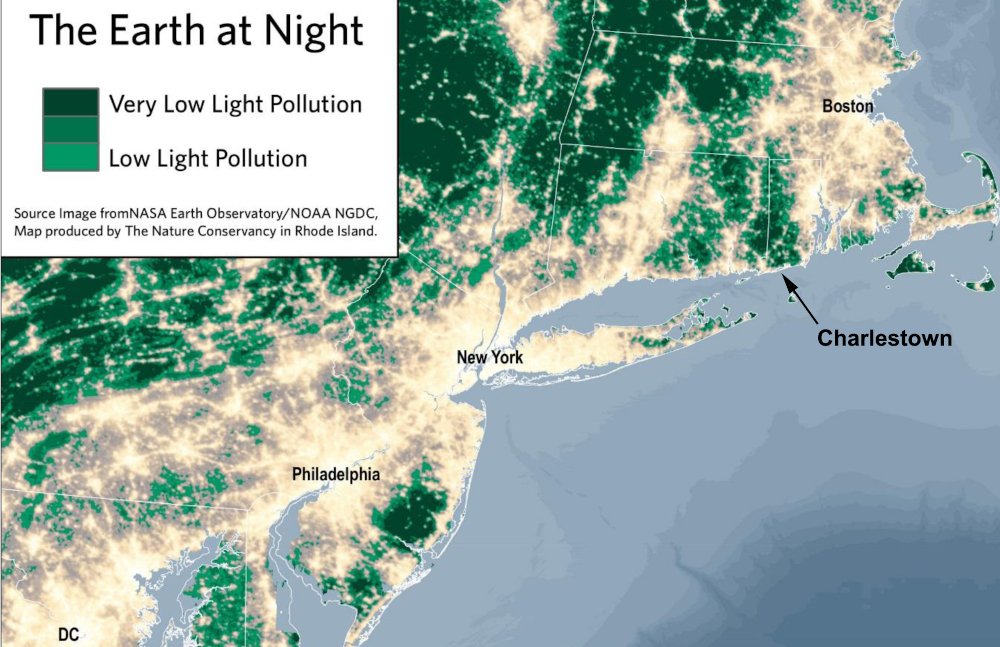With 3 Billion Fewer Birds, What Should Charlestown’s Role Be?
Since 1970, North America has lost 3 billion breeding adult birds from the total bird population. Across the continent, that’s one in four birds gone. For shore birds and all birds in the Atlantic Flyway, which Charlestown is a part of, things are even worse with one in three birds gone.
These declines in bird populations were published in 2019 in the journal Science. Cornell scientist Ken Rosenberg led an international team of scientists from seven institutions in the analysis of population trends for 529 bird species. According to the paper’s authors, these bird losses are a strong signal that our human-altered landscapes are losing their ability to support birdlife. The scale of loss described in the Science study is unlike anything recorded in modern natural history. There have been losses in individual species before, but this is a loss in almost every bird species, from the most rare to the most common.
The popularity of birding in general, 100 years of Christmas Bird Counts, and other bird surveys make birds the most highly counted and studied wildlife group. Migrating birds also show up on weather radar, and those data show the same steep decline in bird numbers. “This loss of bird abundance signals an urgent need to address threats to avert future bird population collapse and associated loss of ecosystem integrity, function and services,” wrote the study’s authors.
Probable causes for these collapsing bird populations are: certain pesticides, collisions with man-made structures, predators like outdoor cats, changing climate, and habitat loss. Habitat loss is considered to be the main cause of bird declines. Development in wild lands and suburban sprawl are examples of habitat loss. Loss of maritime shrubland is one of those disappearing habitat types that is contributing to the rapid decline in bird populations.
The map below shows routes for the fall migration in the Atlantic Flyway. In the spring these routes reverse and the birds fly from South and Central America, Florida, and other southern states to as far north as the Arctic. One of the main routes, for both the north and south migrations, passes through southern Rhode Island.

The Atlantic Flyway contains more than a third of the human population of the United States. Along the coast these are highly developed areas with little habitat for birds to rest and feed.
The “Earth at Night” graphic above shows less developed areas with low light pollution in green. Locate Charlestown on this map and then follow the green column to the Massachusetts border. These are the darkest, least developed areas of Rhode Island. And in the regional context, it is part of the only undeveloped area along the Eastern Seaboard that connects the Atlantic Ocean to the inland forests of New England and Canada. The arrow on the map above is pointing to the location of the Ninigret National Wildlife Refuge. Looking at this map you can see how important Ninigret National Wildlife Refuge is to birds migrating along the Atlantic Flyway. During the spring migration after days flying near some of the biggest, most brightly lit metropolitan areas in the world, Ninigret National Wildlife Refuge offers migrating birds the first true respite, darkness and a gateway to miles of relatively unfragmented open space on their journey north. In the fall it offers a place to rest and fatten up before embarking on this same path south along an urban coast line.
The numbers of birds migrating through Charlestown is significant. The bird banding station at the Ninigret National Wildlife Refuge has the highest counts of any banding station in New England, with a very high proportion of young birds making their first migration. Not only are the total numbers significant, over 30 of the species banded on the refuge are species of high conservation concern in the United States.
Maritime shrubland habitat is very important to migratory songbirds. Many migrant species, including those that normally eat insects, alter their diet during the fall migration to take advantage of the berries and other fruit produced in this habitat. Migrating birds can more rapidly replenish energy reserves while foraging on fruits compared to other diets. These shrublands are scarce in Rhode Island, but Ninigret National Wildlife Refuge’s large patch of maritime shrubland is hundreds of acres in size and is one of the largest stands of this habitat on the coast.
Given the scarcity of this habitat type and its high use by migratory songbirds, it is important to maintain and protect this migratory habitat that is key to the maintenance of songbird populations.
In the years 2010 through 2012 the then Charlestown Town Administrator and members of CCA’s current political opposition proposed three industrial scale wind turbines and lighted football fields in Charlestown’s Ninigret Park. Both of these proposals were stopped by the National Park Service because they threatened to cause migrating and nesting birds to avoid the Ninigret National Wildlife Refuge that is next to the Town’s park.
Avoiding the refuge represents a high risk of negative effects to the bird species that use the refuge. Migrating birds arrive at the refuge exhausted and thin. Without the rest and food that the refuge provides, migrating birds are much less likely to survive.
Ninigret National Wildlife Refuge is permanently protected, but more intense development on nearby public land and thoughtless destruction of forests and shrubland elsewhere tends to chip away at the value of the refuge to those species it was created to protect.
Habitat loss has contributed to North America losing one quarter of all birds in just 50 years. Losing the use, or even part of the use, of a scarce habitat like the Ninigret National Wildlife Refuge, will push even greater losses.
Learn more about the steep decline in North America’s bird population:
- The scientific paper that has quantified the losses is available at https://www.birds.cornell.edu/home/wp-content/uploads/2019/09/DECLINE-OF-NORTH-AMERICAN-AVIFAUNA-SCIENCE-2019.pdf
- An easier to read explanation of the above paper is at https://www.allaboutbirds.org/news/vanishing-1-in-4-birds-gone/
- Learn what you can do to help at https://www.3billionbirds.org/

You can learn more about the author, Ruth Platner, at her profile page.

November 10, 2021 @ 2:35 am
I was born and raised in Cross Mills,R.I. After getting married ,we lived all over the country.My husband was a C.P.O in the Seabees for twenty yrs.I ‘m now living in TX .As a child growing up in Charlestown I remember going to bed, we had screens on our windows so they were usually was open and I loved listening to the Whip Por Wills.and also the Bob Whites.Do you still have them in Charlestown?
November 16, 2021 @ 7:47 am
I do still occasionally hear a Whip-poor-will, but sadly I have not heard a Bobwhite in many years. I live in the northeast section of Charlestown, not Cross Mills.
November 8, 2021 @ 6:46 pm
Thank you Ruth, for the article, Bonnie for the list of native plants and info, and other commenters, I agree and appreciate all. The canary in the coal mine comment is so true but not just about birds, but also the wider problem of “ Habitat Loss” in almost every environmental problem from loss of turtles to climate change.
1 billion people estimated on the planet in the year 1800, 9 billion now, 221 years later. Let that sink in!
We have become the invasive species, but no one wants to address that because lower birth rates would be “bad for business” … as there would be less customers for future economies. But as we see, even sustainable energies have issues that may harm the environment in other ways. The problem is us. We can’t technologize our way out of exploding populations. All of our needs use up Earth’s Recources and land – from food to clothing to housing, staying warm in winter, cool in summer etc etc. I’ve said it before and will say it again. Birth control is one of the easiest solutions. We , the general population have gone about our work and lives, letting “ the experts” figure out the problems ( and look where that has brought us, and we did not know all of this even ten years ago. But Now we know.
I do have hope though that more of us trying to do our part creating back yard habitats for pollinators such as bees and butterflies, and birds is helping. It’s not enough, but hopefully every bit will help sustain these precious creatures and perhaps one day they will grow in numbers. For example, even though monarch butterflies have been devastated in the west with drought and wild fires, and the Midwest with milkweed loss in farms along their migratory routes, folks across the country are learning and becoming more aware , planting native and pollinator friendly gardens without herbicides and pesticides. This was the best year to see monarch butterflies in my neighborhood in 6 years.
November 7, 2021 @ 4:57 pm
This was first published in November, 2019, but the issues are still relevant and the challenges for migrating birds are only getting more extreme.
November 19, 2019 @ 10:58 pm
1. Public needs to be educated.
2. Plant trees.
3. Improve and make recycling mandatory.
November 19, 2019 @ 6:09 pm
I was recently at the Rhode Island Natural History Survey conference. One presenter was looking at what birds need to fuel their journeys in migration. Native shrubs and other plants are definitely their best choice providing fat and antioxidents and carbohydrates in their fruits and berries. These were the favored ones – Northern arrowwood, winterberry, bayberry, Virginia Creeper, Chokeberry and pokeweed. If they do not have access to these type of plants they may not make the journey alive. Ninigret Wildlife Refuge and the wilder parts of Ninigret Park help provide some food. Invasive plants do not always fulfill the same needs. Anything else that stresses such as disturbances by animals and humans just make their lives more compromised. Birds help control insect and pest infestations while feeding their young. Getting rid of all insects is counterproductive. I’m glad we have the areas that might help them survive. Thanks for the article.
November 19, 2019 @ 11:52 am
Hooray to Ruth Platner for an excellent article which makes clear that Charlestown has a key role to play in ecological damage control. The dramatic decline of birds reported in the hyperreputable journal, Science, is clearly a “canary in a coalmine” warning that things are seriously out of whack and the Earth at Night map underscores the town’s critical position for making a difference. Yes, it’s an issue for birds and bird-lovers but the roles birds play in pest control, seed dispersement and other yet to be discovered ecological functions locally and internationally are only just beginning to be understood. Let’s keep Charlestown dark at night and naturally rich around the clock!
November 19, 2019 @ 9:04 am
Thanks Ruth for a great article. US and global bird losses are a huge issue that has been widely reported this year. I feel great that Charlestown is very actively doing its bit to help reduce these losses. Lets please keep this up and keep resisting those in town who want to promote noisy and bright light events at Ninigret, and who demean “we must not disturb the birds”. Let them hold their events in areas that are already noisy and brightly lit, and leave the peace and quiet of Charlestown to those of us residents that value that … and to the birds that value it also.
I agree with Ms Clinton above. Fran and I also backyard-feed the birds and we have also seen the population decline. Following her example, this year we have not seen any grackles whereas upto a few years ago we would get flocks of 30’ish in number.
Go birds and bird-lovers.
November 18, 2019 @ 7:36 pm
I feed birds in my backyard and have since 1971.
Most years, in September and October, I am visited by flocks of up to a hundred Grackles which stick around for days, stuffing themselves for their trip south. This year I only saw maybe 10 or 12 Grackles. What happened to the flocks?
Mind you, I’d just as soon do without them – they are noisy and drive away my regular visitors, but I certainly don’t want them harmed.